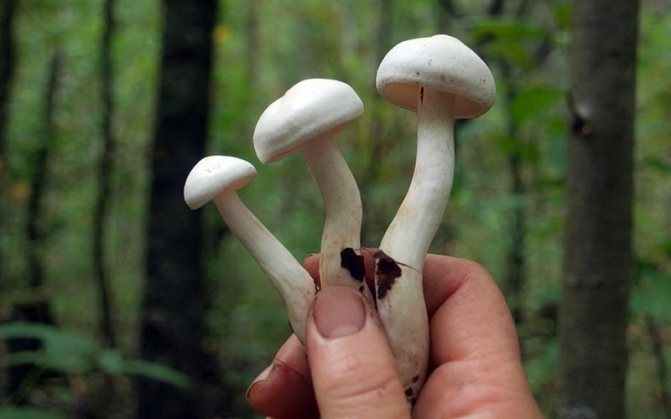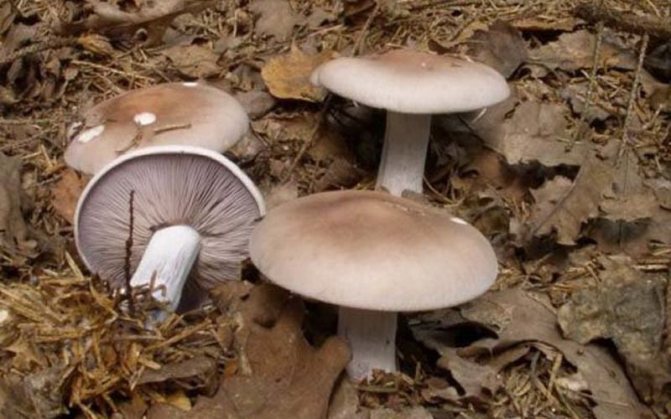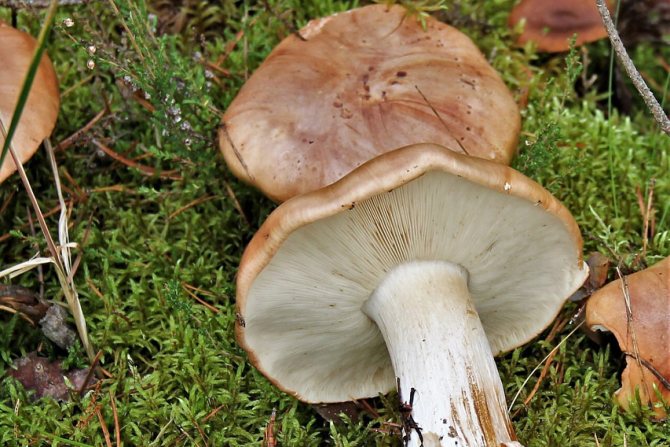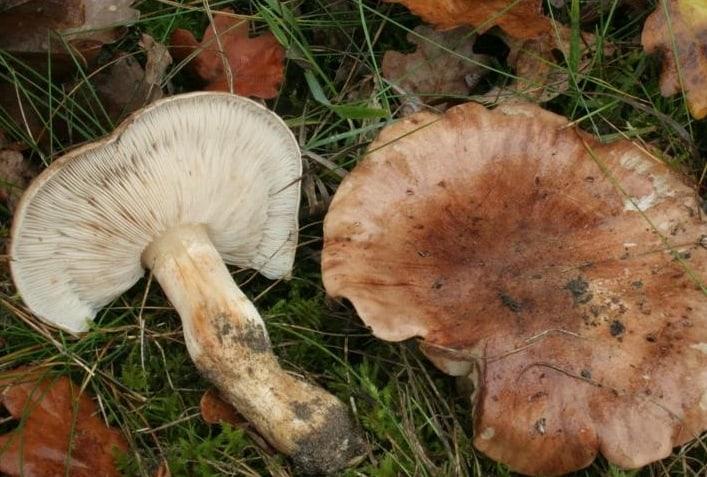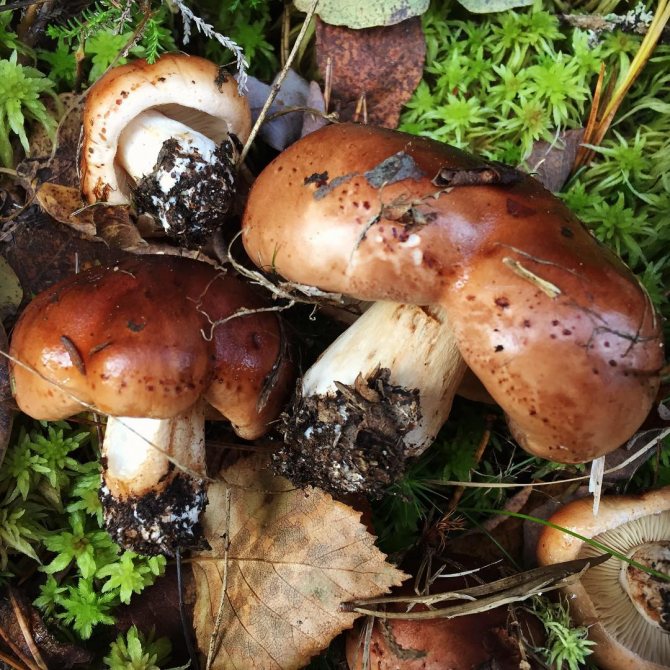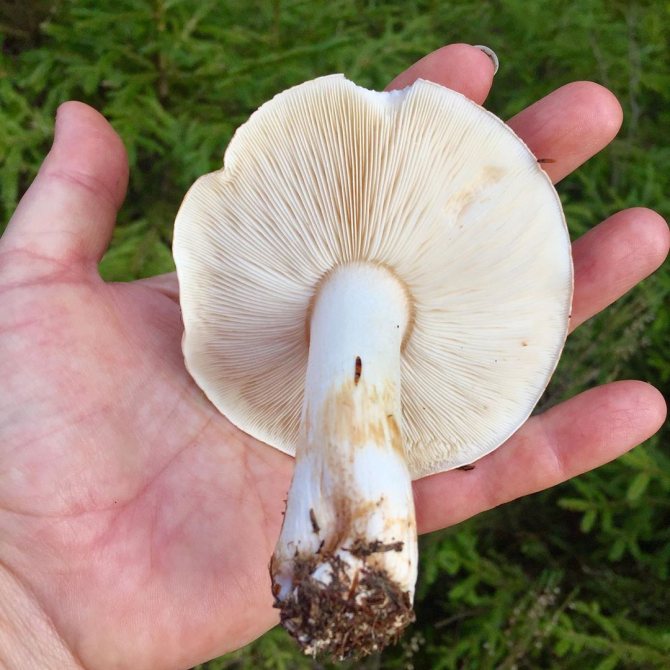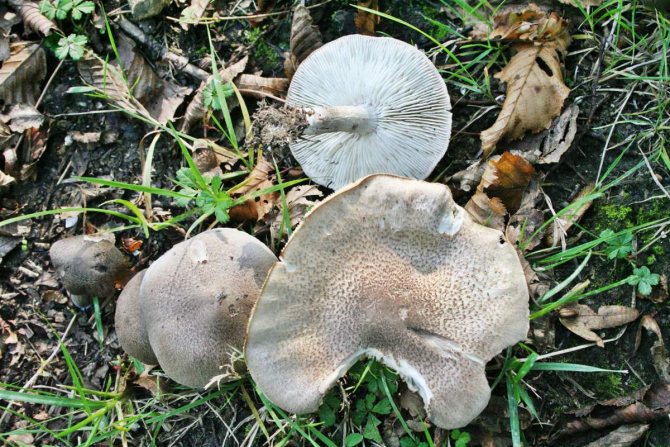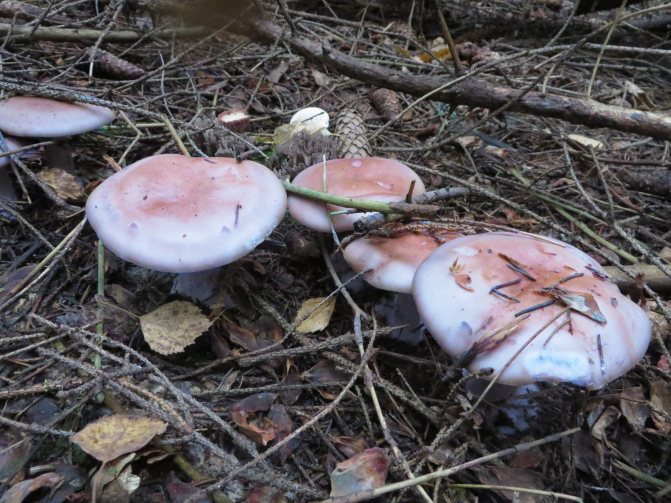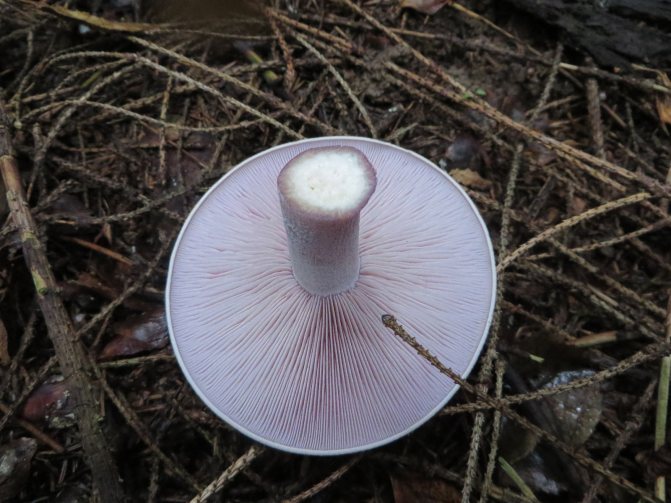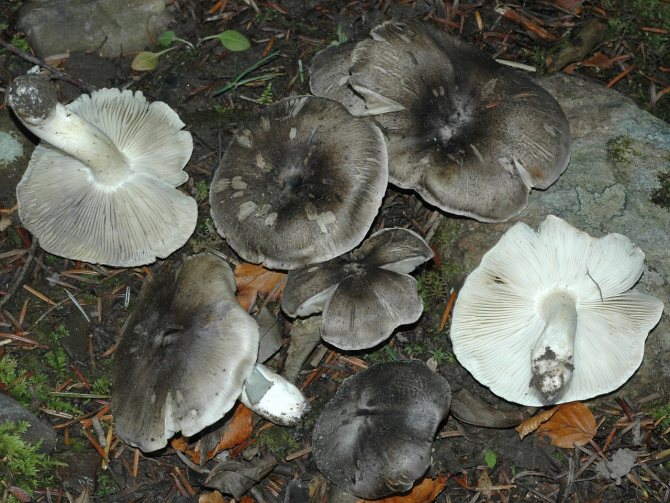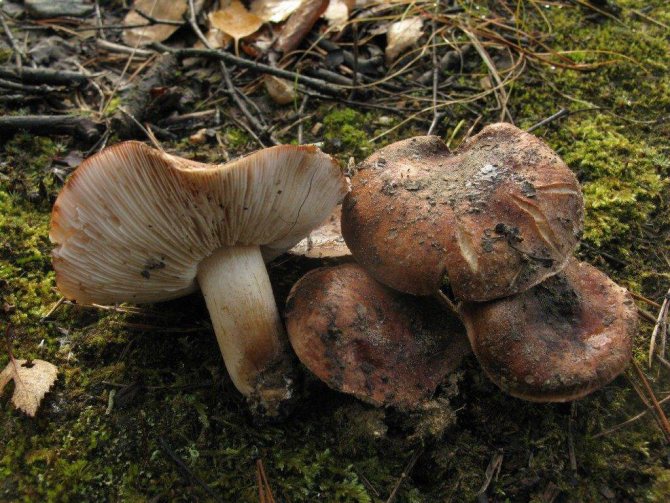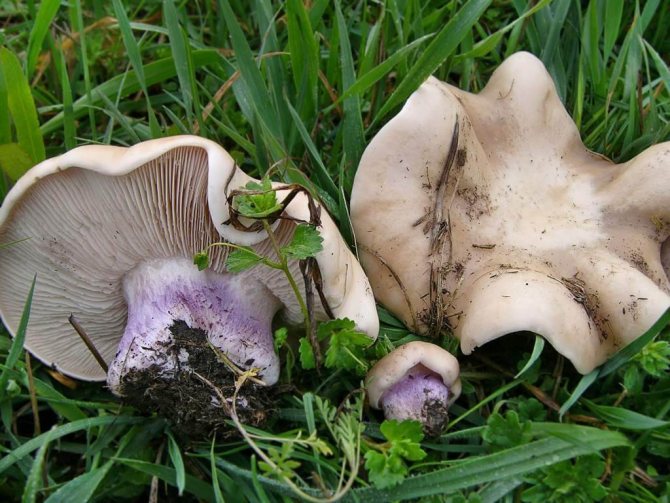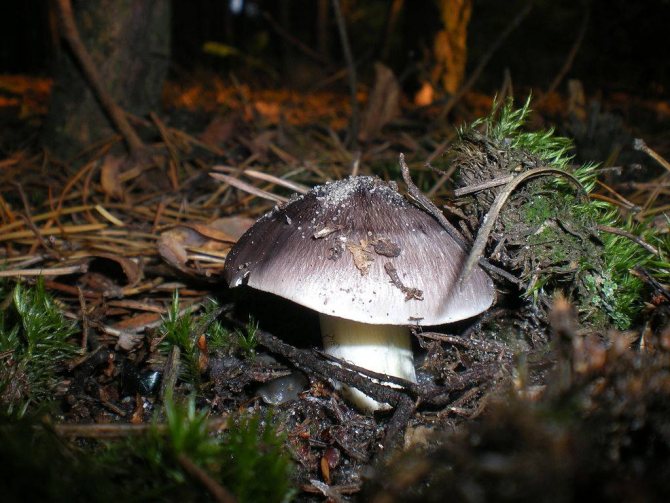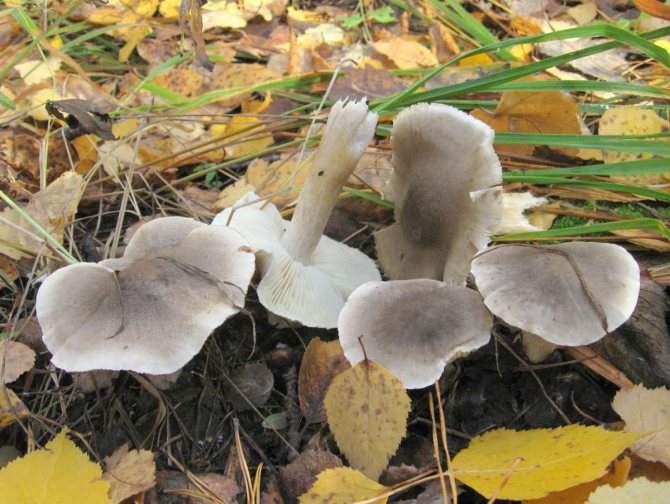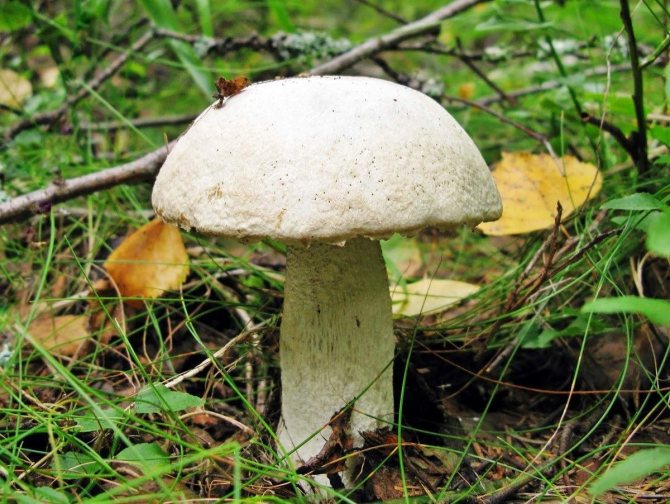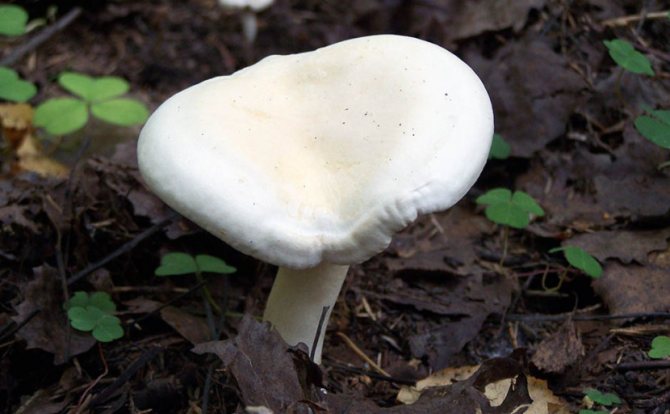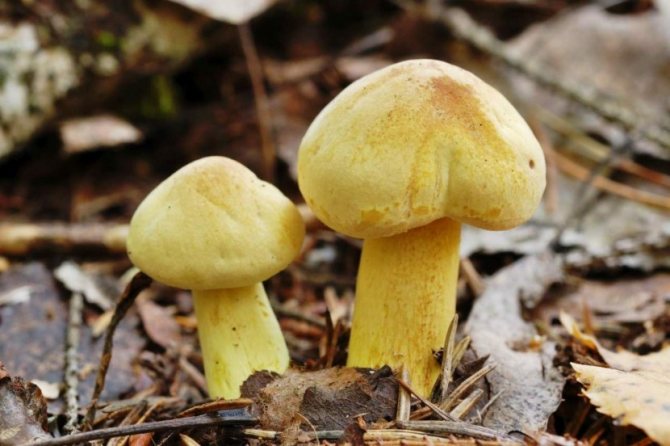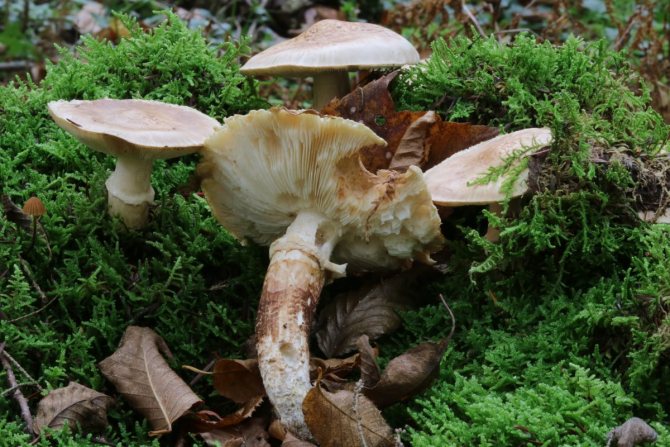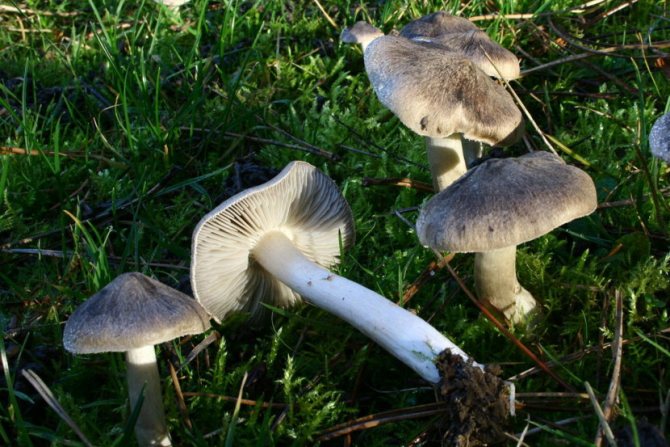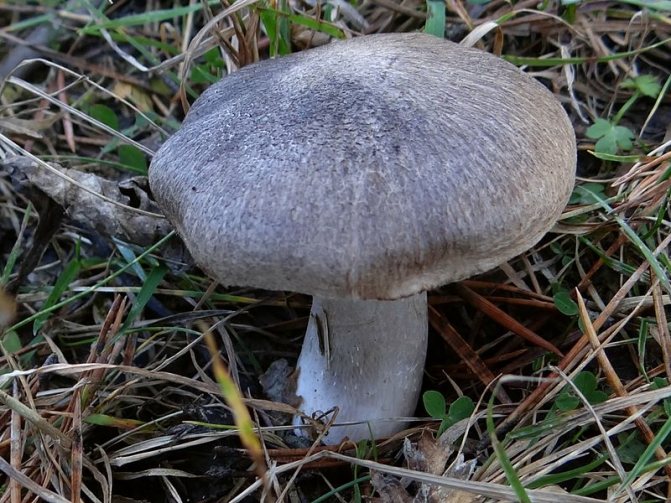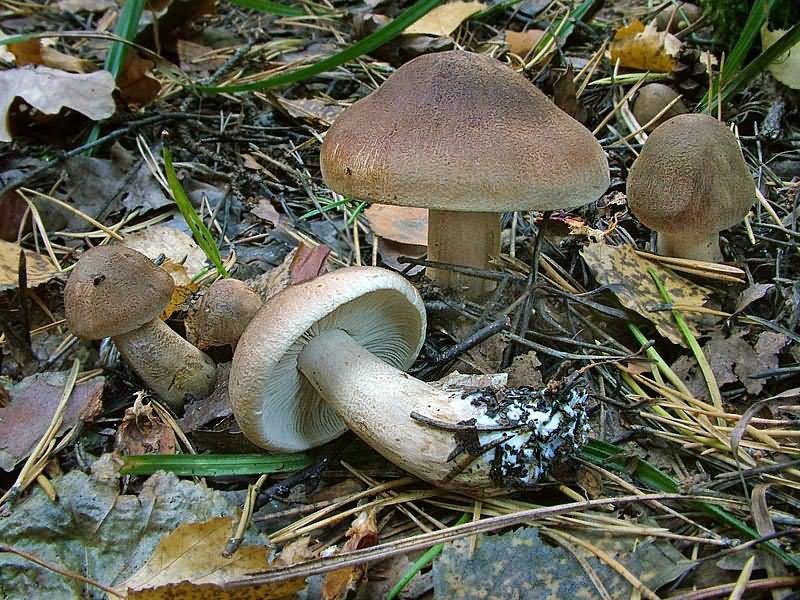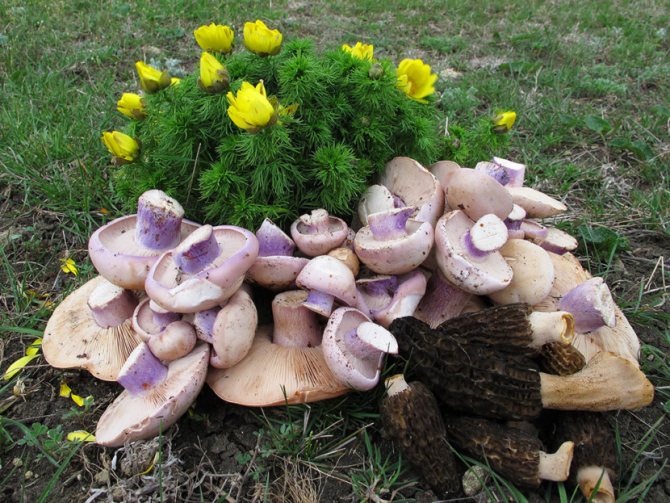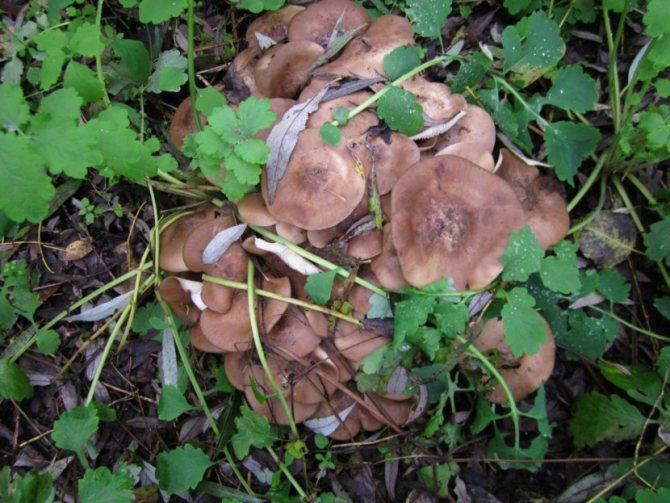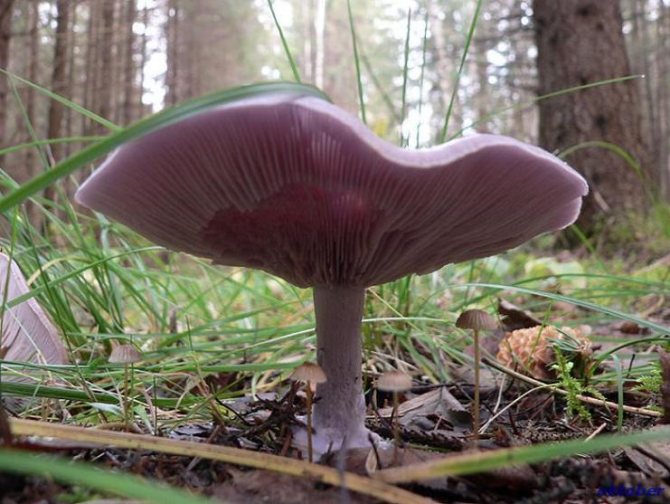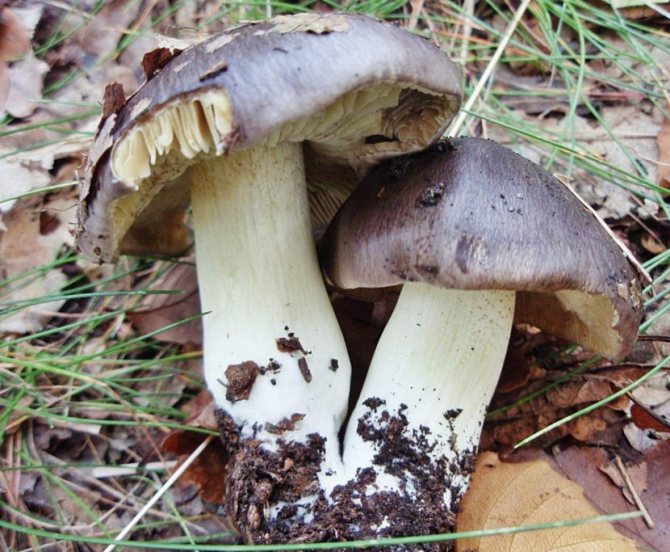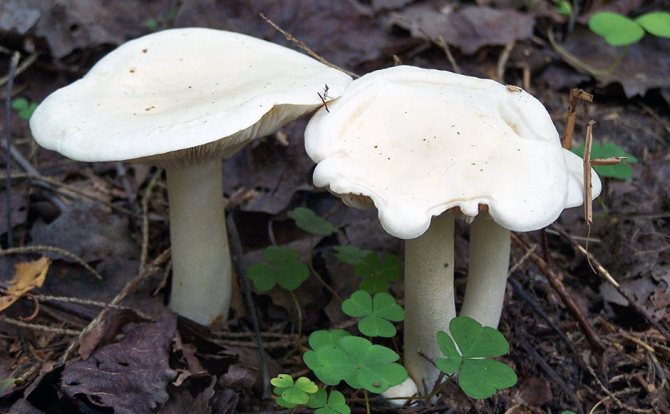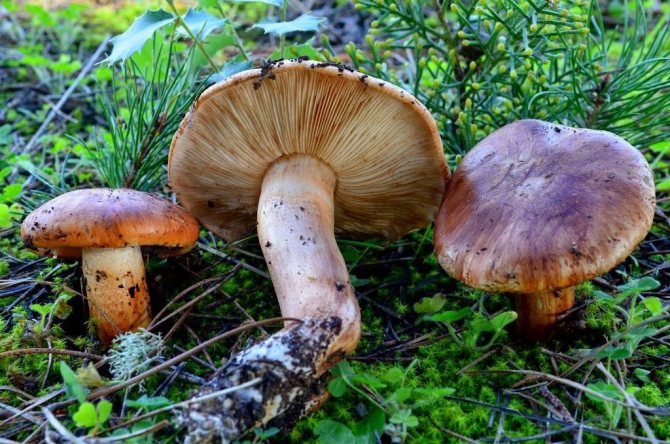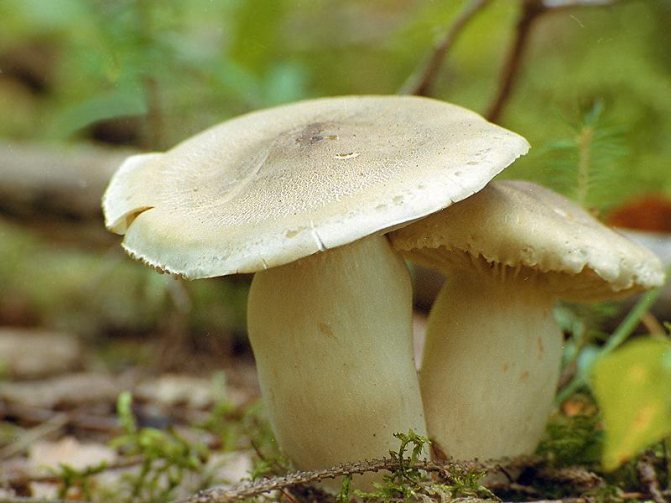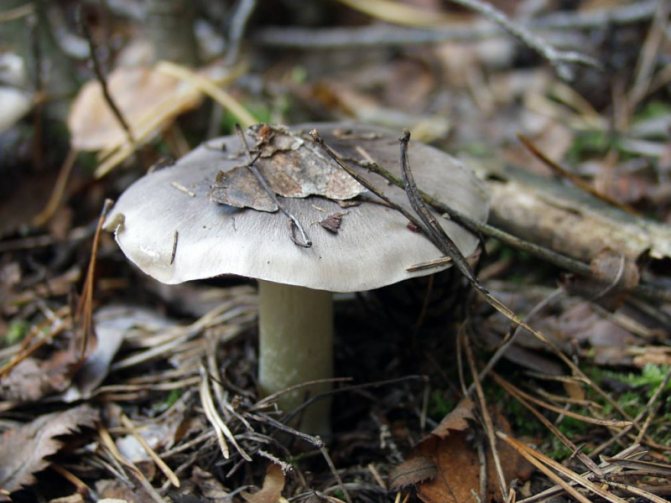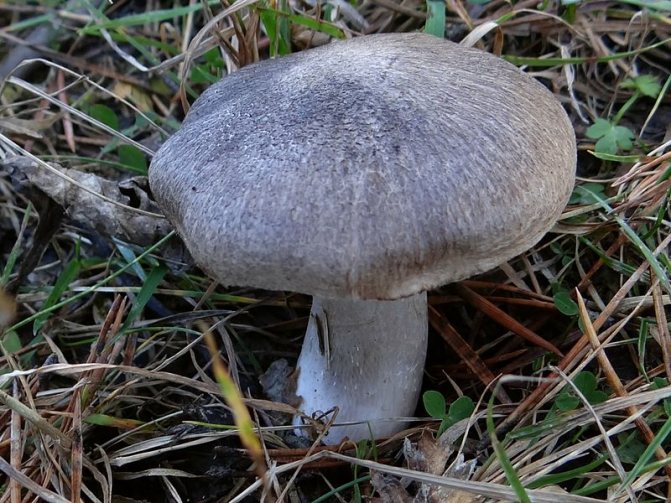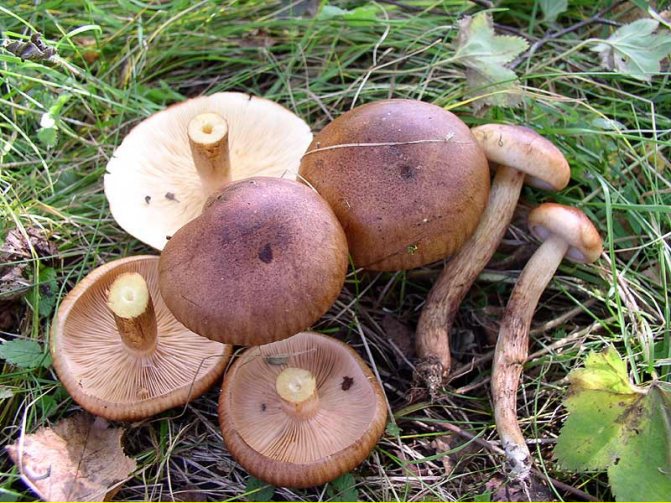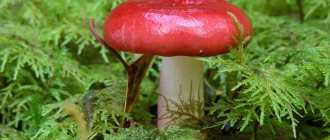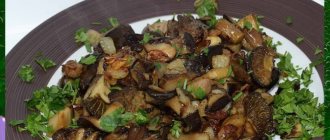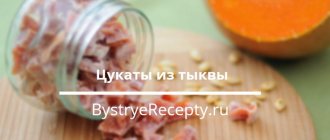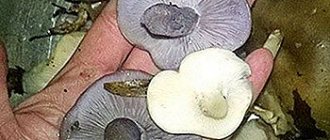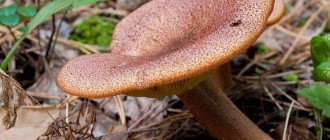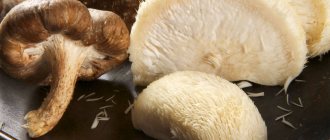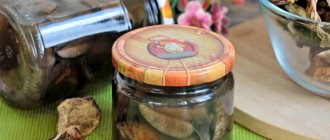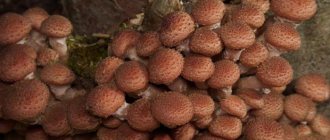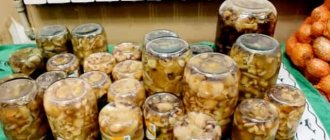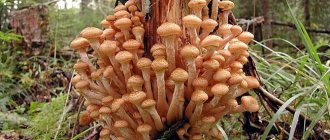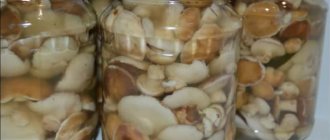Gray ryadovka is a good edible mushroom that grows in autumn in coniferous and coniferous-deciduous forests. How to distinguish the gray ryadovka (another name is streaky ryadovka) from similar mushrooms? How to cook gray ryadovka?
Hello dear reader!
There are many edible mushrooms in the forests of European Russia. We just do not know all of them. But to call all unfamiliar mushrooms "toadstools", as is often practiced, I think, is unreasonable.
It is better to simply study the found mushrooms more closely, to get acquainted with their signs, to memorize them. Which is not at all difficult, there would be a desire.
It is better to learn to distinguish edible from poisonous mushrooms. Poisonous mushrooms just need to be remembered! There are very few highly poisonous and deadly poisonous mushrooms in our forests - you can literally count them on your fingers!
Mushrooms are also worth remembering. In order not to return from the forest with an empty basket. For example, in the fall, you should not ignore the gray (shaded) rowing.
Rows: a delicious recipe for making mushrooms for the winter
For a standard, but at the same time, the most proven recipe for cooking for the winter, you will need the following ingredients:
- The rows themselves with purple and white hats (about a kilogram);
- Coarse salt;
- Water;
- Bay leaf;
- Peppercorns;
- Vinegar.
First, sort them into white and purple. This is a very important step, which is one of the key in the process of marinating the product. Next, clean the product from debris.
Actually, you can start the cooking process:
- Thoroughly rinse the rows, changing the water three times until the dirt is completely gone;
- Add a kilogram of product, three tablespoons of six percent vinegar and pepper to the water;
- Also, add the bay leaf immediately and do not forget to salt to taste;
- You must add all the ingredients except the vinegar and bring to a boil;
- Remove foam and simmer;
- Cook for an average of about one and a half hours;
- One hour after cooking or twenty minutes before the end, pour vinegar into the pan;
- Next, you need to sterilize the banks for ten minutes;
- Arrange the mushrooms in jars.
Please note that pickled rows can be eaten immediately after cooking, although most housewives still prefer to stock up for the winter.
Edible mushrooms ryadovki: types, description, names, photos
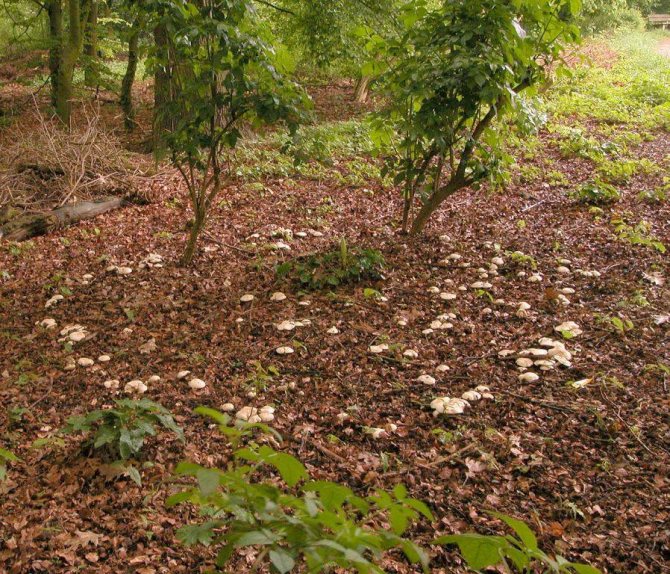
Edible mushrooms ryadovki: types, description, names, photos
Rowed mushrooms grow in heaps in a row, sometimes forming "witch circles". If you see a whole row or circle of mushrooms near a tree, then these are rows. Now it remains only to figure out which of them are edible and which are poisonous.
You can save this article to your phone or print a photo on a color printer so that you can see and compare those mushrooms that you come across on your way. There are 2000 varieties of row mushrooms. Only 81 species are more or less well-known, and the following rows are considered the most common species in our forests:
- Mayskaya
- Matsutake
- Purple-footed
- Giant
- Yellow-brown
- Purple
- Gray
- Bored
- Topoleva
- Yellow-red
- Green
- Earthy
The rest of the species are almost never found in our country and mushroom pickers know nothing about them.
Types, description, names and photos of edible row mushrooms:
The row is gray (from the Latin Tricholoma portentosum). In a young individual, the cap resembles a ball with a diameter of 4 cm. In an adult mushroom, it reaches a size of 12 cm and becomes flat and has bumpy irregularities. The leg is smooth, whitish with a gray-yellow tint. The plates are massive, but rarely spaced from each other. In a young individual, it is white, and then they acquire a yellow or gray tint. The cut pulp has a yellow tint, and has a light but persistent aroma.
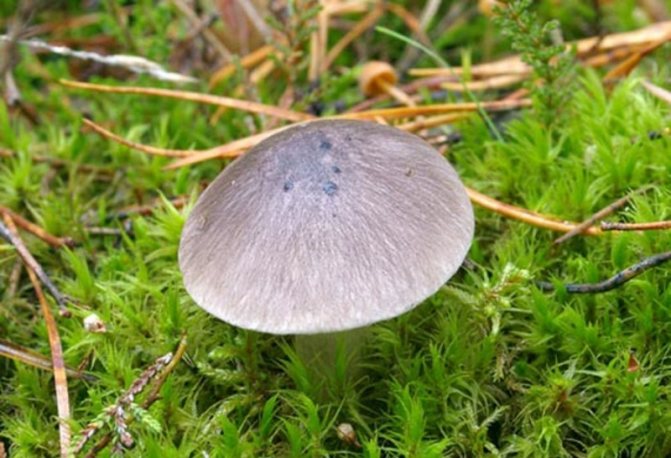

Edible row mushrooms: photo of a gray row
Lilac-footed row (from Latin Lepista personata, Lepista saeva). The main difference between this mushroom is the lilac color of the leg. The hat is wide in diameter from 6 to 15 cm. It often has a glossy, even surface with a yellow-violet tint. There are many plates, they are massive and have a beige color. Young individuals have a fibrous film in the form of a ring on the stalk.
The fruit pulp has a pleasant and delicate fruit aroma, sweet aftertaste and gray or gray-violet color. This mushroom is often mistaken for an inedible species. A distinctive feature lies precisely in the taste, color and aroma of the pulp fabrics. The inedible mushroom has an unpleasant specific aroma, which after a few hours only gets worse and resembles the smell of rotten vegetables.
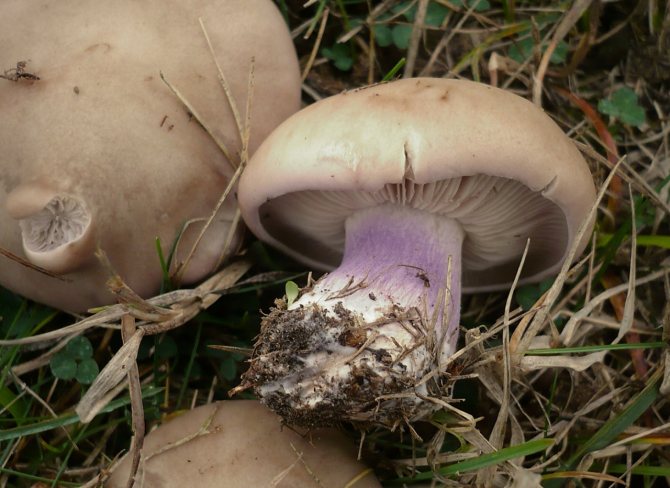

Edible mushrooms - lilac-footed rows - can be confused with inedible
The row is earthy (from the Latin Tricholoma terreum). Mushrooms 1-3 days old have a small cap - 3-9 cm, cone-shaped. Then the cap becomes almost almost flat with a slight rise in the middle. Has a grayish color, which can be diluted with a brown tint.
This type can be found with a reddish hat, closer to a brick one. The leg is up to 9 cm long and up to 2 cm in diameter. The plates are sparsely arranged, with an uneven pattern and have a gray tint. The pulp is fleshy, without a pronounced mushroom or coniferous aftertaste with a light flour aroma.
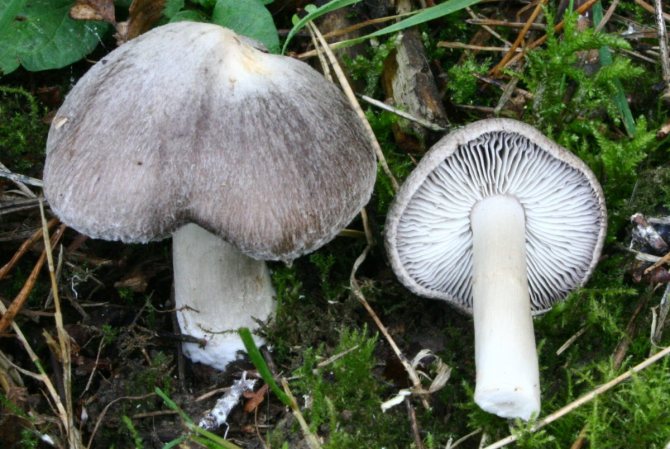

Edible mushrooms ryadovka: photo of ryadovka earthy
Mushroom-ryadovka Matsutake (from Latin Tricholoma matsutake). It is appreciated in oriental cuisine due to its specific bouquet of pine aromas and delicate spices. The delicious mushroom taste makes you fall in love with the dishes prepared with this mushroom. The wide silk-surfaced hat is brown in color and can be up to 20 cm in diameter.
A mature mushroom may crack the cap and show a prominent white flesh. The leg is long - up to 20 cm, up to 2.5 cm thick. A fibrous ring can be seen under the cap. The plates are of a beautiful light shade, the fleshy structure is white with a pleasant aroma of cinnamon.
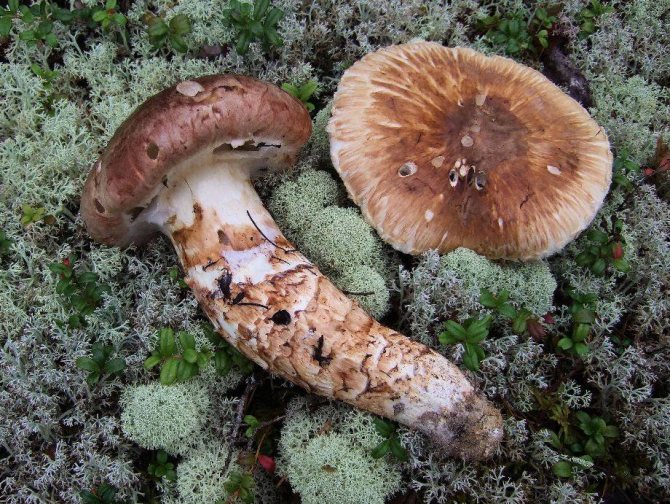

Edible ryadovka mushrooms: photo of Matsutake mushroom
The row is giant (from the Latin Tricholoma colossus). The diameter of the cap can reach 20 cm. The round, resembling the shape of a ball, in a young mushroom, over time, is replaced by a flat-spread cap in an adult mushroom. The skin of the cap has a pronounced smoothness, brick shade, with a light stripe along the edge. The leg has a tuber-shaped seal at the mycelium.
The thickness can reach 6 cm in diameter, the height is 10 cm. The plates are often located, pure white, in older individuals they can have a brick-brown hue.
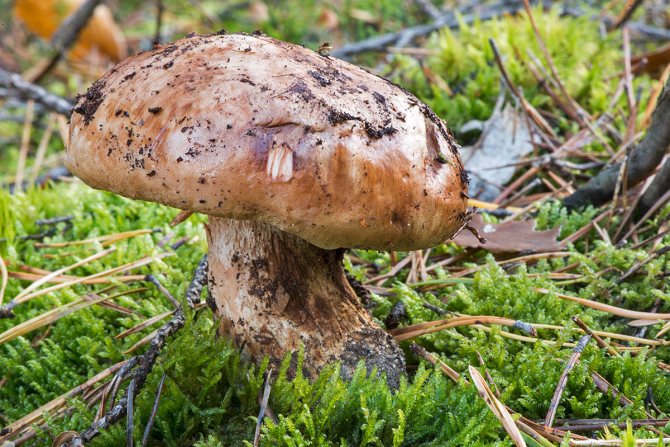

Edible ryadovka mushrooms: view - giant ryadovka
The row is yellow-brown (from the Latin Tricholoma fulvum). A mushroom 1-3 days old has a slightly raised cap. As it grows, it will become flat-spread with a hill in the middle. The peel of the fruiting body sticks to the fingers, maybe with flaky scales. The diameter of the cap reaches 15 cm, the color is brick with a red tint, a light shade around the edges.
The leg is slightly thickened in the area of the mycelium. The plates can be located rarely or, conversely, often, but they are uneven. The color of the plates is light yellow, then they are covered with a brown round pattern. The fleshy structure is white or slightly yellow, bitter in taste and has a pleasant pine aroma.
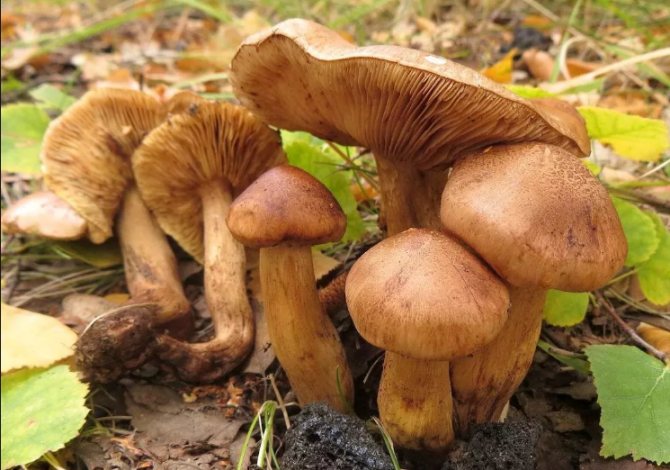

Edible mushrooms rowing: type - yellow-brown rowing
Crowded row (from Latin Lyophyllum decastes)... It is considered a low quality mushroom. Hats in the form of a ball, with edges tucked inward, concave in the middle. The diameter of the cap can be from 4 to 12 cm. The surface is smooth-velvety, slightly scaly with a gray tint. In an adult, the color of the cap becomes gray-light. The legs of the mushrooms are light, grow together.
One heap can contain up to 20 or more individuals. Leg length up to 80 mm, thickness up to 25 mm. The leg stands straight or can be slightly tilted to the side. The lamellas are often spaced apart, even but not perfect. The fleshy structure is dense, brown or grayish, with a flour aroma and a delicate pleasant taste.
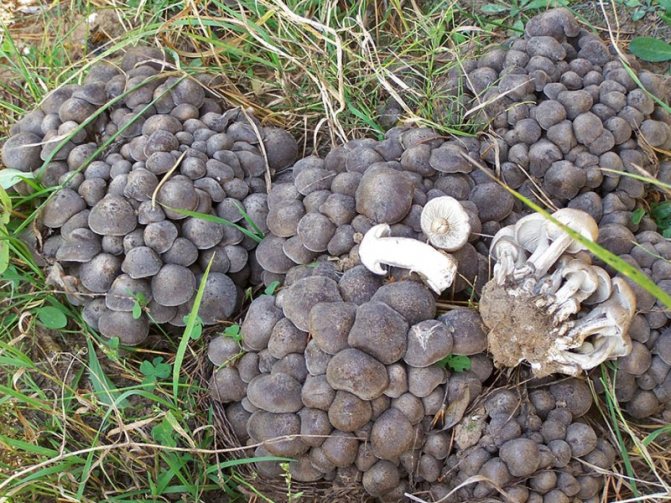

Edible mushrooms - crowded row
May row (from Latin Calocybe gambosa)... It bears this name, as it can be found in the coniferous forest in May. The diameter of the cap is only 4-6 cm. Its shape in young individuals is flat-spread with a slightly round bend. A mature fruiting body is characterized by a convexity of the cap with a small sweep at the edges. Fibrous peel, as if strewn with flakes.
Color from light beige in young, to white in mature individuals. If the mushroom is overripe, the cap will be yellow. The leg is straight - 4-9 cm, up to 3.5 cm thick. The color of the leg is white-yellow, the base is brick-colored with a yellow tint. The lamellas are often located. They have a white tint in a young fruit tree, then they become creamy. The pulp is white with a pleasant aroma.
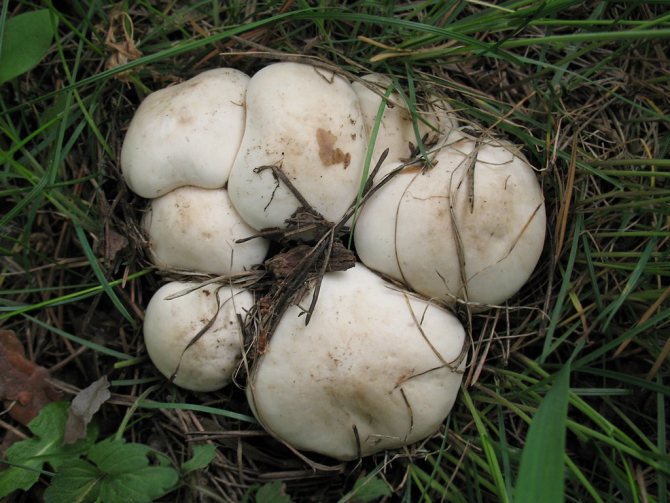

Edible mushrooms - ryadovka may
Poplar ryadovka (from Latin Tricholoma populinum). It is considered a conditionally edible mushroom. In the regions of our country, where there are few other types of mushrooms, it is collected by mushroom pickers and delicious dishes are prepared from such a mushroom, as from a valuable food product. A hat with a diameter of 6 to 12 cm is distinguished by a slight bulge, then it becomes sweeping, but not even. The skin is slimy and sticky to the fingers, has a gloss, yellow-brown color.
The leg is from 3 to 8 cm long, up to 4 cm thick. The young fruiting body has a light shade, then it acquires a red-brown color, and if you press, it will darken. Lamellae are white, in an adult fruiting body they are brown and with a brick color in overgrown mushrooms. The fleshy structure is white with a flour aroma. In the cap, the flesh can be pink, in the leg it is brick-colored with a grayish tinge.
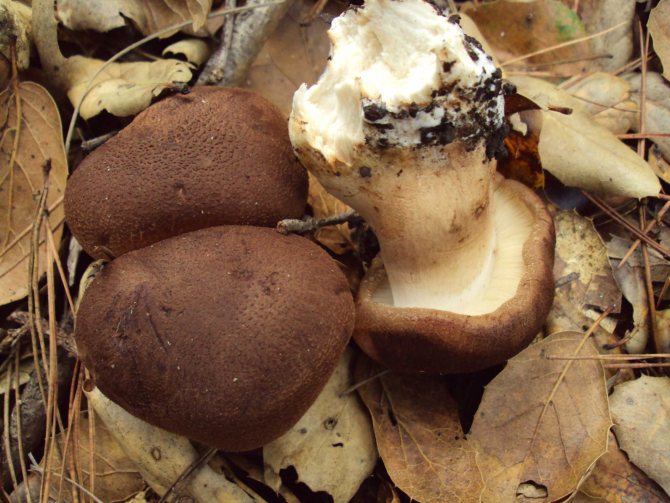

Edible mushrooms - poplar rows
The row is purple (from the Latin Lepista nuda). Conditionally edible mushroom. The cap of large and mature individuals can reach a size of 20 cm. A young mushroom has a spherical cap. Then it straightens out and becomes prostrate or concave inward with curved edges. The purple color of the smooth and glossy skin fades as the mushroom matures.
In an adult fungus, it becomes brownish or light brown in color. The leg is high - up to 10 cm, thickness - up to 3 cm. Slightly thickened at the base. Top covered with flakes. The stem is purple and brightens as the mushroom grows. The plates are thin, often spaced, and purple in color. Overgrown mushrooms have brown plates. The pulp is also purple, but of a light shade. Then it turns yellow. Has a delicate taste and aroma of anise.
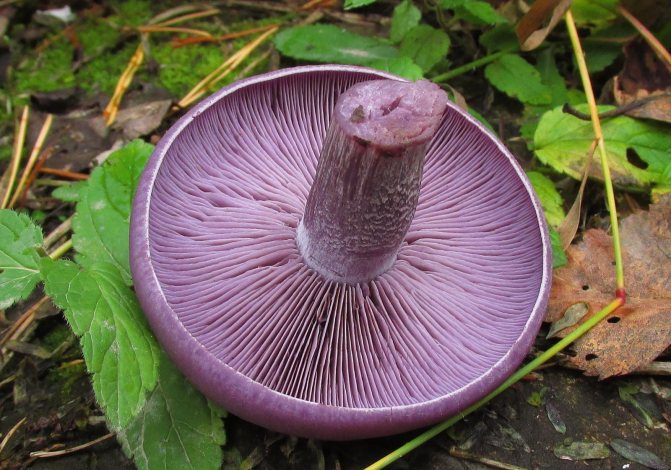

Edible mushrooms - purple ryadovka
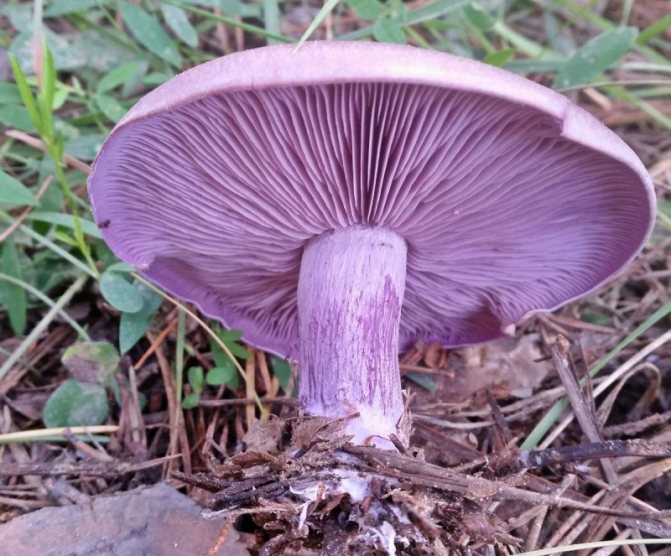

Edible mushrooms ryadovka: type purple ryadovka
The row is yellow-red (from the Latin Tricholomopsis rutilans). Conditionally edible mushroom. It is even considered inedible due to its bitter taste and sour smell. But this mushroom makes delicious first courses. Experienced mushroom pickers collect it and freeze it in the refrigerator for the winter. The cap is rounded in a young individual, and then open in a mature individual.
Diameter up to 15 cm. The skin is dryish, slightly velvety, orange in color with a yellow tinge. There are small scales throughout the cap.The leg is high - up to 10 cm, thickness - up to 2.5 cm. There is a thickening at the base. The color of the leg is the same as that of the cap. The plates are yellow, slightly wavy. The pulp is a juicy yellow hue, has a characteristic bitterness and a smell of wood.
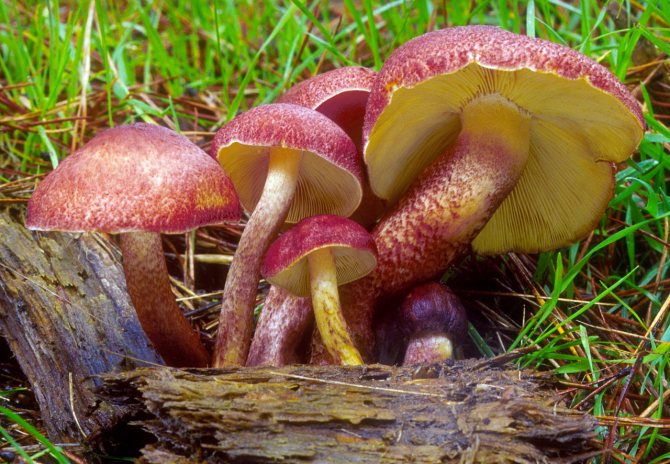

Edible mushrooms ryadovka: type yellow-red ryadovka
Greenfinch row (from Latin Tricholoma equestre, Tricholoma flavovirens). Conditionally edible mushroom. The green color of the mushroom flesh remains even after cooking. Many guides claim that this mushroom is poisonous, as deaths have been recorded after eating it. But in regions where there are few other mushrooms, this type is consumed without fear. For example, in the south of Russia, it grows in the sand. Mushroom pickers find such a mushroom by a crack on the surface of the sand. The mushroom cap is large - up to 15 cm.
In a young individual, it is convex, then it becomes prostrate. The skin of the cap is slightly slimy, green-yellow in color. Often covered with sand, as this type of row grows in such a substrate. The leg is even, yellowish-green, up to 9 cm long. At the base it is strewn with flakes. The plates are often arranged, yellow or greenish in color. The pulp is white, but turns green-yellow as it ripens. This mushroom has a flour smell and a mild taste. It is recommended only to salt it, since its weak taste is lost during heat treatment.
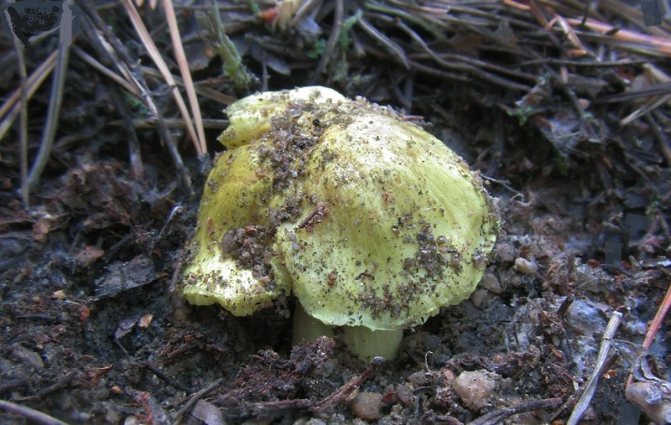

Edible mushrooms ryadovka: type ryadovka-green tea
Photo gallery
Where does the gray ryadovka grow?
Usually the mushroom grows in the temperate zone of the northern hemisphere: in Canada, in North America, Western, Northern and Eastern Europe, in the Far East. The main Russian regions of growth: Central Russia, the Urals, Siberia (Novorossiysk), Crimea.
Read also: Saussurea - useful properties and uses of Saussurea
The fruiting period usually starts in early September and ends during frost (late November). The most widespread fruiting is from the end of September to the first half of October.
Most of all ryadovka gray edible is widespread in coniferous (especially in pine) and mixed forests and, as a rule, on sandy soil, in mosses and under deciduous-coniferous litter. It grows not only in groups. It is often found in the same places where there is greenfinch, and their growth period is simultaneous. It is popularly believed that the described ryadovka is almost a sister of the green stuff, which is why they sometimes call it greenery.
Pickled blue feet: a step by step recipe
Popularly, mushrooms are nicknamed blue feet, although in fact they have spruce legs or purple, depending on the subspecies growing in the area. You can pickle such a mushroom according to the usual recipe, but there are still some differences from the standard procedure.
Take the following ingredients:
- Three kilograms of blue feet;
- Allspice;
- One and a half tablespoons of salt (how much everyone decides to taste);
- Lemon acid;
- Bitter pepper;
- Garlic.
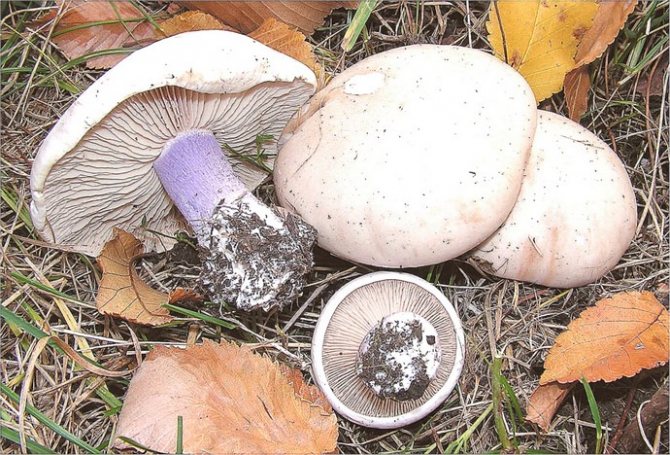

Traditionally, rinse the product from dirt and start cooking.
- Peel the garlic, then chop it along with the eggplant;
- It is important to cut mushrooms not in large, but in medium pieces;
- Pour the mushrooms into a prepared bowl and fill with water;
- Blue feet are boiled for about half an hour;
- It is important to rinse the mushrooms under running water after boiling;
- Now we return the mushrooms to the bowl, add pepper and salt to taste;
- At the end of cooking add citric acid and allspice;
- Cook for another half hour.
This completes the basic preparation. It remains only to close the rows in the banks.
What to do with the rows after harvesting
What should be done with the mushrooms in rows after they have been brought home?
What else should be done with the rows to prepare for further use? Fruit bodies, in order to remove bitterness from them, must be boiled.
- Boil water in an enamel saucepan and pour in vinegar (1 tbsp of vinegar is required for 1 liter of water).
- Put the peeled rows in boiling water and boil for 15 minutes.
- Drain the water, pour in a new portion (with vinegar) and cook for 15 minutes.
- Peel the onion, cut it into 2 pieces and toss over the mushrooms.
- Cook for 10 minutes, put in a colander and rinse with cold running water.
Rows prepared in this way are ready for further cooking processes.
I would like to note that usually ryadovki of any kind are salted and pickled. In this state, they are so tasty that after trying just one mushroom, you will love this appetizer. We offer several recipes showing what you can do with rows.
How to salt a purple row for the winter
Purple rows are the name in everyday life. It is correct to call them poplar or poplar rows. We'll need traditional ingredients, but pickling itself will be different from pickling.
Let's take the following products:
- A kilogram of mushrooms;
- Garlic;
- Horseradish leaves;
- Dill;
- Peppercorns;
- Coarse salt - 50 grams.
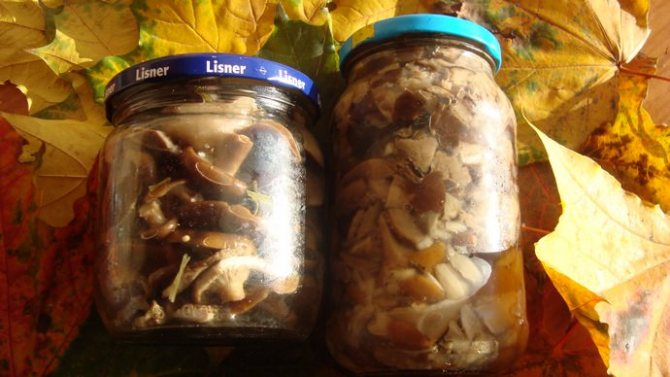

On the eve of cooking, the purple rows must be thoroughly rinsed. No other action is required.
- Boil the rows for an hour (the time is indicated approximately);
- Place horseradish leaves at the bottom of sterilized jars;
- It is necessary to lay out gradually in layers;
- Sprinkle each layer with plenty of salt and add garlic;
- Finally, screw the jars tightly.
They will be salted only after six to eight weeks. Moreover, the shelf life is also limited. Some people believe that you can keep them in a cold place for about three years, but this is dangerous. It is not recommended to consume a salted product for a period of more than a year.
The easy way to marinate
First, the marinade is prepared. For 1 kg of mushrooms per 1 liter of water, take:
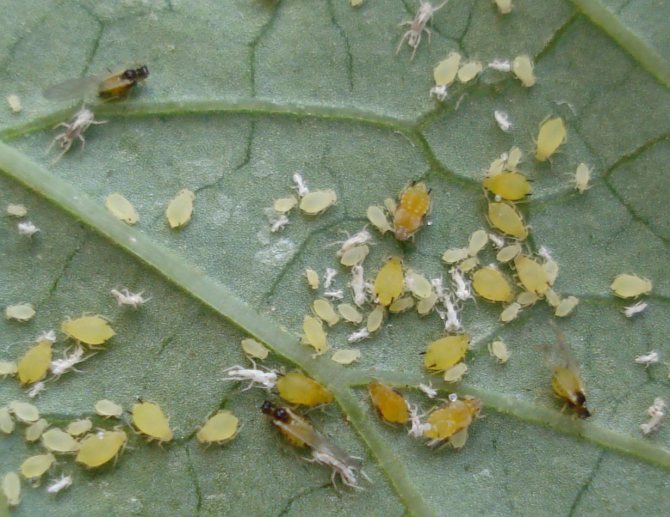

salt - 1 tbsp. the spoon;- bay leaf - 2 pcs.;
- cloves - 3 pcs.;
- sugar - 2 tbsp. spoons;
- vinegar - 1 tbsp. the spoon;
- allspice - 3 peas.
The mushrooms are boiled in the marinade for 15 minutes. Then they are laid out in sterilized jars, poured with hot marinade, vinegar is added and covered with lids. Store the jars in a dark, dry, cool place.
How to make pasta with mushrooms in a creamy sauce
It is interesting that in Russia ryadovki are not very much appreciated, they are referred to the last fourth category on the scale of nutritional and nutritional value. And in a number of countries, for example, in Japan, they are considered delicious mushrooms.
Unusual recipes for cooking ryadovka for the winter at home
It is wrong to think that this type of mushroom can only be boiled and then salted. There are a huge number of recipes that involve the heat treatment of mushrooms. To get started, try cooking fried rows for the winter. A minimum of products are required. Actually, in addition to the mushrooms themselves, take vegetable oil and salt. This is a very simple recipe, but when prepared correctly, this method will bring you a lot of joy on cold winter evenings.
Follow the step-by-step instructions:
- Cut off the legs at the base so that there is no earth or sand;
- Traditionally, wash the mushrooms in a little water;
- Boil them for about 50 minutes;
- Let the water drain (use a prepared drushlag);
- Fry for an hour and a half, seasoning the rows with a large portion of vegetable oil; Salt during cooking (do not spare salt, as they should be salty enough);
- Arrange in jars and prepare lids so that you can start closing the product right away;
- Pour in vegetable oil and close tightly.
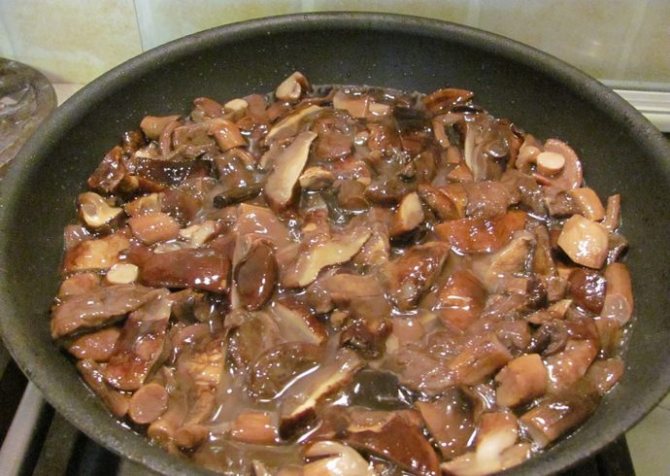

Such a dish is also stored in the refrigerator.True, it is allowed to place cooked mushrooms in a cold cellar.
Appearance and habitat
The ryadovka or govorushka mushroom forms fruiting bodies with a distinct division into a cap and a leg. In representatives of the genus, the cap is flat (this is characteristic of mature mushrooms, but in young ones it is hemispherical), with lamellar hymenoforms, it differs in color in different species. The leg is long, cylindrical in shape.
Rows are ground types of mushrooms. More often, the mycelium chooses the soil next to conifers. Individuals grow in heap in small groups. They can form annular colonies - "witch circles". There are many places where ryadovki grow: they are forest, meadow, grow in groves and even parks.
Irina Selyutina (Biologist):
It is important not to forget that most types of rowers are mycorrhizal formers, which prefer coniferous species as symbionts, most often choosing pine and less often larch, spruce and fir. Only rare species of the genus form mycorrhiza with deciduous trees (beech, oak, birch). Poor sandy or calcareous soils of coniferous and mixed forests are chosen as habitats.
The genus got its name because of the "predilection" of representatives to grow in rows or in groups. In some regions of the Russian Federation, they are even called "mice".
Geographically, the types of rows cover the whole of Russia. The species grows in the Crimea. Crimean mushrooms are actively harvested from early spring to mid-winter due to the warm climate. Basically, the time of fruiting of the genus is autumn, because it is the autumn fruiting bodies that reach their peak of fleshiness and quantity. Some species appear in the spring, while others bear fruit until cold weather. The ryadovka mushroom unites many species, the description of which will be useful to every mushroom picker, so as not to send false mushrooms to the basket, and then to the plate.
Array
Preliminary processing
Rows must be processed before cooking. This is done not only for hygienic purposes, but also in order to destroy harmful and weakly toxic substances. The step-by-step processing looks like this:
- mushrooms are cleaned with a brush from sand, moss, leaves and other debris;
- with a knife they cut off rot, dark places, traces of rodent bites and wormholes;
- then soak for 1.5-2 hours in cold water, it is recommended to change the water several times;
- dipped in boiling water and boiled for 10-12 minutes;
- table vinegar is added to boiling water at the rate of 1 teaspoon per liter of water;
- the water is drained, the mushrooms are cooled to room temperature;
- the cooled mushrooms are boiled again for another 15-20 minutes, then the boiling water is poured off and the mushrooms are cooled with cold water.
It should be noted that mushrooms are perishable foods. Literally a few hours after cutting, they become unsuitable for human consumption. Therefore, it is immediately recommended to start their preprocessing. If there are too many mushrooms, some of them can be frozen or dried in reserve.
Freeze and dry for the winter
Freezing is the easiest way to preserve mushrooms for later cooking. Rows boiled as a result of pre-processing are cut into pieces. Placed in portions in food containers or plastic bags and placed in the freezer. Frozen rows are stored for one year.
Rows are dried in the oven. The mushrooms are cut lengthwise into thin slices. Then the plates are placed in one layer on a baking sheet. It is advisable to cover the baking sheet with parchment. The mushrooms are dried for an hour at a temperature of 70 C. They must be stirred every 15-20 minutes to prevent scorching.
After drying, the mushrooms must be stored in a dry, dark and well-ventilated place.
Making mushroom soup
Purple rows are best for making soups. The fact is that when cooked, they taste and smell like chicken meat. There are many recipes on how to cook a purple row. The ingredients for the most popular of these are:
- purple rows - 0.4 kg;
- potatoes - 3 pieces;
- vermicelli - 100 g;
- carrots - 1 piece;
- water - 2 l;
- onion - 1 piece;
- parsley root - 1 piece;
- spices to taste.
Recipes for delicious chicken breast and champignon salads
Place purple rows cut into pieces in boiling water. Add potato slices, noodles, parsley root, salt and spices to taste. Chop and fry the carrots and onions, pour the vegetables into the soup after 20 minutes of boiling. Cook for another 5 minutes.
How to fry and stew the seedlings
Of all types of lamellar mushrooms, the gray row is suitable for frying. The recipes for cooking fried rows are not complicated, and the dishes are very tasty. To cook a fried gray ryadovka, you need to take:
- gray rows;
- onion;
- a pinch of dill seeds;
- vegetable oil;
- black pepper;
- flour;
- salt.
Cut the mushrooms into pieces and add to the pan with heated oil. When the water released by the mushrooms begins to evaporate intensively, they are salted, pepper and dill seeds are added. After the water has evaporated, sprinkle two tablespoons of flour on the mushrooms and mix. Then add the onion cut into half rings and continue frying until the onion is ready. The total frying time is 18-25 minutes.
Braising is suitable for all types of edible rows. It differs from frying in that the pan must be covered with a lid. Stew the mushrooms over low heat for 30 minutes.
Stewed rows with sour cream are very tasty. To do this, 10 minutes before readiness, add two tablespoons of 20% sour cream to the pan.
How to distinguish edible from inedible and poisonous rows
It is important to be careful when picking up the rows. The danger lies in the fact that mushrooms may be simply poisonous or at least unsuitable for food. Purple and poplar, the most popular varieties, are edible. Fortunately, they are the most common.
Still, remain vigilant, as a poisonous ryadovka in appearance for an inexperienced mushroom picker may resemble an edible mushroom. When ripe, they smell like stale radish. Moreover, their color is gray or dull white. Avoid these mushrooms. Better to play it safe and throw out the product at the first doubt. Poisoning can be very serious when eaten.
Growing places
The generic name for gray ryadovka is tricholoma. This group includes many species, among which there are poisonous and conditionally edible. There are also edible and inedible ones, and the second group is not toxic to humans, but does not represent nutritional value. Thus, all varieties of tricholoma are divided into 4 groups. From the point of view of botanists, ryadovka is a lamellar above-soil fungus, the genus is agaric, the family is rowovy or tricholomaceous.
Eating red fly agaric: how to cook a mushroom properly
The distribution area of the fungus is a place with a temperate climate located in the Northern Hemisphere. As a rule, rowers are mycorrhizal formers. In the process of life, they form mycorrhiza on the roots of trees. Plants with which Tricholoma is in symbiosis:
- fir;
- beech;
- oak;
- larch;
- spruce;
- Birch.
The fungus prefers calcareous soils, poor sandy loam and sandstones. It can often be seen in mixed and coniferous forests. Most of the species bear fruit from late summer until frost, and only a few at the end of spring. In addition to witch circles, fruiting bodies can grow in straight rows, singly and in small groups.
Rowing canning (video)
Cooking the row is not much different from the traditional pickling of mushrooms. Even a novice hostess can cope when following the necessary instructions and following proven recipes. Try traditional cooking methods first.The taste of these mushrooms is quite unusual, therefore, before making large stocks, you need to understand whether this mushroom is suitable for eating for you and your loved ones. Always be careful when picking mushrooms for cooking and do not risk your health by eating suspicious specimens.
Useful properties and restrictions on the use of boiled mushrooms
Rows are rich in minerals and B vitamins. Also, the fruit body contains carbohydrates (49%), proteins (46%) and fats (5%). Due to the content of potassium, phosphorus, zinc, copper and other useful substances, tricholoms have antioxidant, antiviral and anti-inflammatory effects, as well as increase the body's resistance to viruses and bacteria.
Regular consumption of this type of food helps to restore the work of the cardiovascular system by normalizing pressure and heart rate. In addition, the use of Trichol will help to cope with overwork and internal stress.
With their systematic use, the blood sugar level is normalized, mental performance increases and the removal of toxins and other harmful substances from the body is activated.
Row poisonous tricholoma pardinum. Row poisonous
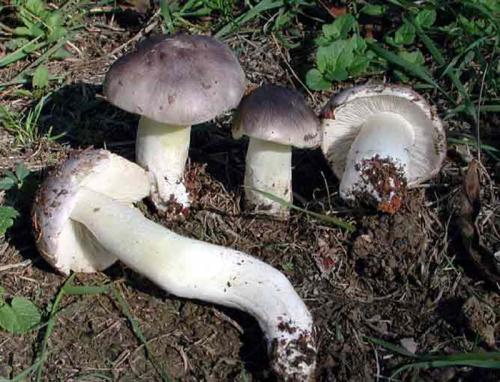

Poisonous ryadovka is a dangerous inedible mushroom. Poisoning is caused by a poorly understood toxin. Row poisonous causes severe stomach upset.
In the huge family Ryadovkovye there are not only harmless edible mushrooms, but also poisonous ones. The most dangerous ryadovka is poisonous. This name aptly reflects the essence of this representative of the mushroom kingdom. The scientific name is tiger ryadovka. In some regions, this dangerous mushroom is called the leopard ryadovka.
Why is this ryadovka dangerous? She, like the fly agaric, creates stomach problems - diarrhea, vomiting. Novice mushroom pickers mistake the tiger row for a standing mushroom only because of its pleasant smell. And in vain, many poisonous mushrooms have a pleasant mushroom smell. It is good that this dangerous ryadovka is rarely encountered on the path of a novice mushroom picker.
Where does the poisonous ryadovka grow?
It is found both in conifers and birch forests throughout central Russia. Prefers calcareous soil. It grows under trees and in forest glades and forest edges. Fruit bodies often form witch circles.
When the poisonous row appears
The first specimens appear in the last decade of July. Mass fruiting occurs from mid-August to October. Fruiting gradually subsides. Rows completely disappear before the first frost.
Description of the poisonous row
The hat initially has the shape of a ball. Over time, it straightens out and becomes almost flat with the edge curled down. A mature hat does not exceed 12 centimeters in diameter. It is dense, dry and fleshy to the touch. The skin of the cap is grayish-white. Flaky scales are located on the skin.
The scales are arranged in concentric circles. The color of the scales is much darker than the skin. When a row is ripe, the skin almost always cracks. Under the cap are wide, sparse and fleshy plates. They are painted off-white with a greenish-yellowish tint.
When ripe, watery small droplets appear on the plates.
The flesh is dense to the touch, off-white in color. At the break, the color does not change, there is a pleasant mushroom smell.
The cylindrical solid leg thickens noticeably towards the base. It is colored white, and at the base the color becomes off-white.
What kind of poisoning does the poisonous ryadovka cause?
Even accidental ingestion of a small amount of this row causes very serious poisoning. Symptoms: nausea, diarrhea, stomach cramps and vomiting. This is the action of a little-studied toxin.
Signs of poisoning appear a maximum of four hours after the ryadovka enters the human stomach.
If you suspect poisoning with a ryadovka, you should immediately proceed to gastric lavage and take activated charcoal.
Soap Tricholoma
The cap of this mushroom is naked and smooth, olive brown, olive green. The edges are pale and the center is reddish. The diameter of the cap is from 3 to 12 centimeters. In young fruits, it is conical, and in mature fruits it is flat-convex, with a tubercle in the middle. The flesh is firm, yellowish or white, begins to turn red at the cut.
These rows are recognized as inedible mushrooms for the reason that they have an unpleasant taste and a soapy-fruity smell. These qualities are not lost even during and after cooking. These tricholoms grow in deciduous and coniferous forests, which are dominated by spruce, pine, oak and beech.

